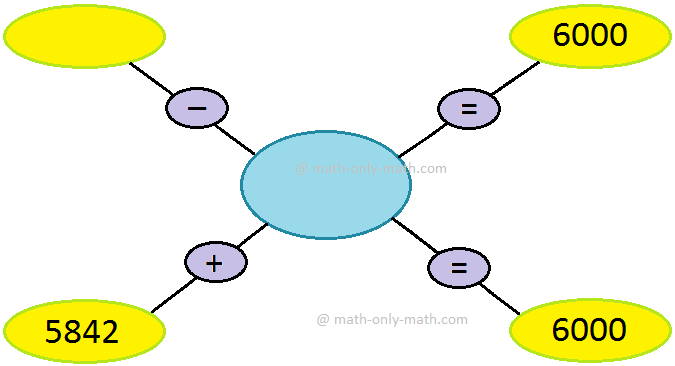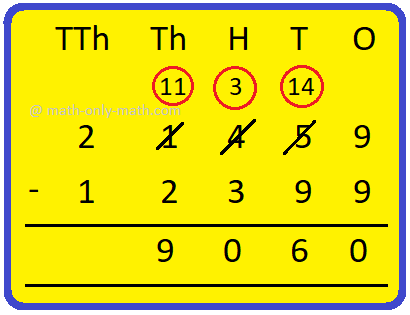General Form of an Arithmetic Progress
The general form of an Arithmetic Progress is {a, a + d, a + 2d, a + 3d, a + 4d, a + 5d, ..........}, where ‘a’ is known as the first term of the Arithmetic Progress and ‘d’ is known as the common difference (C.D.).
If a is the first term and d is the common difference of an Arithmetic Progress, then its nth term is a + (n - 1)d.
Let a\(_{1}\), a\(_{2}\), a\(_{3}\), a\(_{4}\), ........, a\(_{n}\), .................. be the given Arithmetic Progress. Then a\(_{1}\) = first term = a
By the definition, we have
a\(_{2}\) - a\(_{1}\) = d
⇒ a\(_{2}\) = a\(_{1}\) + d
⇒ a\(_{2}\) = a + d
⇒ a\(_{2}\) = (2 - 1)a + d:
a\(_{3}\) - a\(_{2}\) = d
⇒ a\(_{3}\) = a\(_{2}\) + d
⇒ a\(_{3}\) = (a + d) + d
⇒ a\(_{3}\) = a + 2d
⇒ a\(_{3}\) = (3 - 1)a + d:
a\(_{4}\) - a\(_{3}\) = d
⇒ a\(_{4}\) = a\(_{3}\) + d
⇒ a\(_{4}\) = (a + 2d) + d
⇒ a\(_{4}\) = a + 3d
⇒ a\(_{4}\) = (4 - 1)a + d:
a\(_{5}\) - a\(_{4}\) = d
⇒ a\(_{5}\) = a\(_{4}\) + d
⇒ a\(_{5}\) = (a + 3d) + d
⇒ a\(_{5}\) = a + 4d
⇒ a\(_{5}\) = (5 - 1)a + d:
Similarly, a\(_{6}\) = (6 - 1)a + d:
a\(_{7}\) = (7 - 1)a + d:
a\(_{n}\) = a + (n - 1)d.
Therefore, nth term of an Arithmetic Progress whose first term = ‘a’ and common difference = ‘d’ is a\(_{n}\) = a + (n - 1)d.
nth term of an Arithmetic Progress from the end:
Let a and d be the first term and common difference of an Arithmetic Progress respectively having m terms.
Then nth term from the end is (m - n + 1)th term from the beginning.
Therefore, nth term of the end = a\(_{m - n + 1}\) = a + (m - n + 1 - 1)d = a + (m - n)d.
We can also find the general term of an Arithmetic Progress according to the process below.
To find the general term (or the nth term) of the Arithmetic Progress {a, a + d, a + 2d, a + 3d, a + 4d, a + 5d, ..........}.
Clearly, for the Arithmetic Progress is {a, a + d, a + 2d, a + 3d, ..........} we have,
Second term = a + d = a + (2 - 1)d = First term + (2 - 1) × Common Difference.
Third term = a + 2d = a + (3 - 1)d = First term + (3 - 1) × Common Difference.
Fourth term = a + 3d = a + (4 - 1)d = First term + (4 - 1) × Common Difference.
Fifth term = a + 4d = a + (5 - 1)d = First term + (5 - 1) × Common Difference.
Therefore, in general, we have,
nth term = First + (n - 1) × Common Difference = a + (n - 1) × d.
Hence, if the nth term of the Arithmetic Progress {a, a + d, a + 2d, a + 3d, a + 4d, a + 5d, ..........} be denoted by t\(_{n}\), then t\(_{n}\) = a + (n - 1) × d.
Solved examples on general form of an Arithmetic Progress
1. Show that the sequence 3, 5, 7, 9, 11, ......... is an Arithmetic Progress. Find its 15th term and the general term.
Solution:
First term of the given sequence = 3
Second term of the given sequence = 5
Third term of the given sequence = 7
Fourth term of the given sequence = 9
Fifth term of the given sequence = 11
Now, Second term - First term = 5 - 3 = 2
Third term - Second term = 7 - 5 = 2
Fourth term - Third term = 9 - 7 = 2
Therefore, the given sequence is an Arithmetic Progress with the common difference 2.
We know that nth term of an Arithmetic Progress, whose first term is a and common difference is d is t\(_{n}\) = a + (n - 1) × d.
Therefore, 15th term of the Arithmetic Progress = t\(_{15}\) = 3 + (15 - 1) × 2 = 3 + 14 × 2 = 3 + 28 = 31.
General term = nth term = a\(_{n}\) = a + (n - 1)d = 3 + (n - 1) × 2 = 3 + 2n - 2 = 2n + 1
2. Which term of the sequence 6, 11, 16, 21, 26, ....... is 126?
Solution:
First term of the given sequence = 6
Second term of the given sequence = 11
Third term of the given sequence = 16
Fourth term of the given sequence = 21
Fifth term of the given sequence = 26
Now, Second term - First term = 11 - 6 = 5
Third term - Second term = 16 - 11 = 5
Fourth term - Third term = 21 - 16 = 5
Therefore, the given sequence is an Arithmetic Progress with the common difference 5.
Let 126 is the nth term of the given sequence. Then,
a\(_{n}\) = 126
⇒ a + (n - 1)d = 126
⇒ 6 + (n - 1) × 5 = 126
⇒ 6 + 5n - 5 = 126
⇒ 5n + 1 = 126
⇒ 5n = 126 - 1
⇒ 5n = 125
⇒ n = 25
Hence, 25th term of the given sequence is 126.
3. Find the seventeenth term of the Arithmetic Progress {31, 25, 19, 13, ..................... }.
Solution:
The given Arithmetic Progress is {31, 25, 19, 13, ..................... }.
First term of the given sequence = 31
Second term of the given sequence = 25
Third term of the given sequence = 19
Fourth term of the given sequence = 13
Now, Second term - First term = 25 - 31 = -6
Third term - Second term = 19 - 25 = -6
Fourth term - Third term = 13 - 19 = -6
Therefore, common difference of the given sequence = -6.
Thus, the 17th term of the given Arithmetic Progress = a + (n -1)d = 31 + (17 - 1) × (-6) = 31 + 16 × (-6) = 31 - 96 = -65.
Note: Any term of an Arithmetic Progress can be obtained if its first term and common difference are given.
● Arithmetic Progression
- Definition of Arithmetic Progression
- General Form of an Arithmetic Progress
- Arithmetic Mean
- Sum of the First n Terms of an Arithmetic Progression
- Sum of the Cubes of First n Natural Numbers
- Sum of First n Natural Numbers
- Sum of the Squares of First n Natural Numbers
- Properties of Arithmetic Progression
- Selection of Terms in an Arithmetic Progression
- Arithmetic Progression Formulae
- Problems on Arithmetic Progression
- Problems on Sum of 'n' Terms of Arithmetic Progression
From General Form of an Arithmetic Progress to HOME PAGE
Didn't find what you were looking for? Or want to know more information about Math Only Math. Use this Google Search to find what you need.
Recent Articles
-
Multiplication Table | Learn Tables from 0 – 25 | Multiplication Table
Jan 14, 25 11:53 PM
In math multiplication table we will learn the tables from 0 – 25. These multiplication tables help the students to learn the essential multiplication facts. Multiplication tables are very important f… -
3rd Grade Math Worksheets |3rd Grade Math Sheets|3rd Grade Math Lesson
Jan 14, 25 11:02 PM
3rd grade math worksheets is carefully planned and thoughtfully presented on mathematics for the students. Teachers and parents can also follow the worksheets to guide the students. -
3rd Grade Subtraction Worksheet | 3-Digit Subtraction Worksheets | Ans
Jan 14, 25 01:57 PM
In 3th Grade Addition Worksheet we will solve how to subtract 3-digit numbers by expansion, subtraction of 3-digit numbers without regrouping, subtraction of 3-digit numbers with regrouping, propertie… -
Facts about Subtraction | Subtraction of Small Numbers|Solved Examples
Jan 14, 25 12:29 AM
The operation to finding the difference between two numbers is called subtraction. Let us know some facts about subtraction which will help us to learn subtraction of large numbers. 1. Subtraction wit… -
Word Problems on Subtraction |Worksheet on Subtraction Word Problems |
Jan 14, 25 12:21 AM
In word problems on subtraction we need to read the question carefully and understand what we need to find out. We know, in subtraction the larger number from which we subtract the other number (the s…





New! Comments
Have your say about what you just read! Leave me a comment in the box below. Ask a Question or Answer a Question.